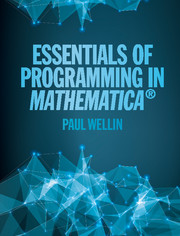1 - Programming with Mathematica
Published online by Cambridge University Press: 05 December 2015
Summary
Mathematica is a large system used across an astonishing array of disciplines – physics, bioinformatics, geo-science, linguistics, network analysis, optics, risk management, software engineering, and many more. It integrates tools for importing, analyzing, simulating, visualizing, reporting, and connecting to other programs. Underlying all of these tools is a modern programming language with which you can extend the things you can do with Mathematica almost limitlessly.
This book focuses on the programming language, but before we dive into details of syntax and structure, it will be helpful to look at some of the essential elements of actual programs to give you a better sense of what it means to program with Mathematica. So, to start, let us walk through the creation of a short program so you can see how a Mathematica programmer might solve a problem. We will not attempt to write the most efficient or shortest code here, but will instead concentrate on the process of programming – things like rewording the problem, finding the right tools and approach, and testing your program. Hopefully, this prelude will give you a better sense of the breadth and depth of the Mathematica language and help you answer the question, “Why use Mathematica to write programs?”
The second aim of this chapter is to help you become familiar with the Mathematica environment, showing you how to get started, how to work with the interface, documentation, and programming tools, and how to start putting them together to do interesting things. The basic syntax used by Mathematica is introduced, including functions and lists and several alternate syntaxes that you can use to input expressions. This is followed by information on how to get help when you get stuck or have trouble understanding an error that has occurred. If you are already familiar with these aspects of Mathematica, feel free to skim or skip these topics and return to them when the need arises.
- Type
- Chapter
- Information
- Essentials of Programming in Mathematica® , pp. 1 - 18Publisher: Cambridge University PressPrint publication year: 2015
- 1
- Cited by

